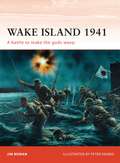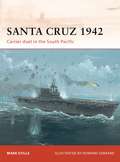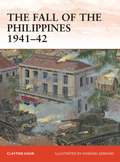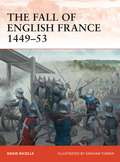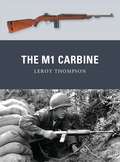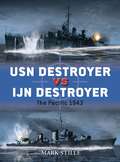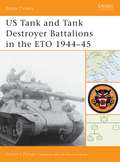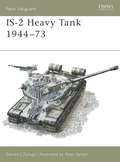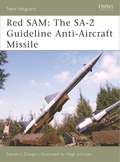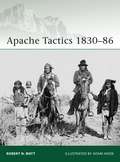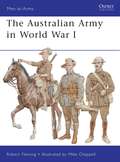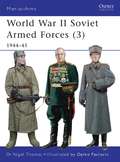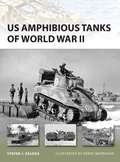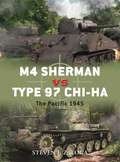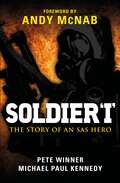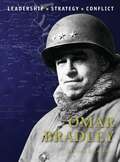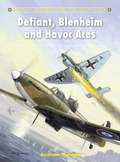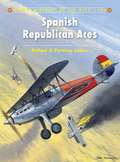- Table View
- List View
Wake Island 1941: A battle to make the gods weep (Campaign)
by Peter Dennis Jim MoranOn the same day that the Japanese attacked Pearl Harbor, they also launched air attacks on Wake Island, an American marine and naval base in the Pacific. Three days later a Japanese invasion force stormed the island, but were bloodily repulsed by the scratch force of marines, sailors and even service personnel who defended it. Despite US attempts to relieve the island, the Japanese launched a much greater invasion a few weeks later and, despite gallant resistance, eventually caused the US Forces to surrender. This book tells the complete story of the vicious fighting on Wake Island, one of the near-legendary 'last stands' made by US military forces.
Santa Cruz 1942: Carrier duel in the South Pacific (Campaign #247)
by Howard Gerrard Mark StilleDespite myth, the Japanese carrier force was not destroyed at Midway but survived to still prove a threat in the Pacific Theater. Nowhere was this clearer than in the battle of Santa Cruz of October 1942. The stalemate on the ground in the Guadalcanal campaign led to the major naval forces of both belligerents becoming inexorably more and more involved in the fighting, each seeking to win the major victory that would open the way for a breakthrough on land as well. The Japanese were able to gain a tactical victory at Santa Cruz and came very close to scoring a strategic victory, but they paid a very high price in aircraft and aircrew that prevented them from following up their victory. In terms of their invaluable aircrew, the battle was much more costly than even Midway and had a serious impact on the ability of the Japanese to carry out carrier warfare in a meaningful manner.
The Fall of the Philippines 1941–42 (Campaign #243)
by Howard Gerrard Clayton ChunIn the immediate aftermath of Pearl Harbor, the Japanese launched an attack on the Philippines to eliminate the United States' other major Pacific naval base. Catching the US forces completely by surprise, the Japanese bombed the major airfields and quickly gained air supremacy. They followed with a full-scale invasion that quickly rolled up US–Filipino opposition and captured Manila. Meanwhile US forces, under the leadership of the Douglas MacArthur, created a series of defensive lines to try and stop the Japanese advance. Despite their efforts, they were continually pushed back until they held nothing more than the small island of Corregidor. With doom hanging over the US–Filipino forces, Douglas MacArthur was ordered to fly to safety in Australia, vowing to return. Nearly five months after the invasion began, the US–Filipino forces surrendered, and were led off on the 'Bataan Death March'. This book covers the full campaign from the planning through to the execution, looking at the various battles and strategies that were employed by both sides in the battle for the Philippines.
LAV-25: The Marine Corps’ Light Armored Vehicle (New Vanguard)
by Henry Morshead James D’AnginaThe Light Armored Vehicle 25 (LAV-25) has played a significant role in transforming United States Marine Corps doctrine since its introduction in the early 1980s. The Marine Corps' Light Armored Vehicle program was based on the proven Swiss MOWAG Piranha series of 4x4, 6x6, and 8x8 wheeled vehicles. However, developing organizational units, tactics, and employment of the weapon system within the force structure of the Marine Corps proved to be more of a challenge than fielding the weapon system. This resulted in multiple re-designations for LAV units within the Corps. The LAV first saw combat in Panama during Operation Just Cause and LAV-25s have fought in every major conflict since, including Operation Enduring Freedom, and Operation Iraqi Freedom. This book covers the design, development, and deployment of this continuingly successful vehicle.
The Fall of English France 1449–53 (Campaign)
by David Nicolle Graham TurnerDespite the great English victories at Crécy, Poitiers and Agincourt, the French eventually triumphed in the Hundred Years War. This book examines the last campaign of the war, covering the great battles at Formigny in 1450 and Castillon in 1453, both of which hold an interesting place in military history. The battle of Fornigny saw French cavalry defeat English archers in a reverse of those earlier English victories, while Castillon became the first great success for gunpowder artillery in fixed positions. Finally, the book explains how the seemingly unmartial King Charles VII of France all but drove the English into the sea, succeeding where so many of his predecessors had failed.
The M1 Carbine (Weapon)
by Peter Dennis Leroy Thompson Alan GillilandIn 1938 the US Chief of Infantry requested that the Ordnance Department develop a carbine to be used by service and support troops, artillerymen, machine-gun crews, tankers, mortar crews and other troops not needing the power of the M1 Garand rifle. The development of this new weapon was given an added impetus by Germany's successful use of airborne and glider troops early on in World War II. This caused a fear amongst US officers that troops normally considered 'behind the lines' personnel might have to fight elite German troops and would therefore require a more effective weapon than their standard pistols. The resulting M1 Carbine was a not a shortened version of the standard service rifle but instead a brand-new design chambering a new cartridge. Eventually numerous manufacturers would combine to produce over six million M1 Carbines before the end of the war. This book charts the complete story of the weapon, from its design, to its operational history and its impact upon warfare.
The M1 Garand (Weapon #16)
by Peter Dennis Leroy Thompson Alan GillilandThe M1 Garand gave the US infantryman a marked edge during World War II. It shot faster and further than enemy infantry rifles and hit harder. No less an authority on killing the enemy than General George S. Patton called the Garand, "The greatest battle implement ever devised.†? At a time when opposing forces were armed with bolt-action rifles, US troops had a highly reliable self-loader. The eight-round clips which were used to load the M1 Garand were, however, viewed with mixed emotions by the troops on the ground. Some Army and Marine Corps troops allegedly felt that the distinctive "twang†? as the Garand's clip was ejected when empty alerted the enemy that the soldiers were reloading and resulted in an attack. But the Garand became the defining mankiller of the war, despite its weight and magazine problems, and many US combat veterans consider it one of the key reasons they survived the war.
USN Destroyer vs IJN Destroyer: The Pacific 1943 (Duel #48)
by Ian Palmer Giuseppe Rava Mark StilleThis book covers the fierce night naval battles fought between the US Navy and the Imperial Japanese Navy during late 1943 as the Allies advanced slowly up the Solomons Islands toward the major Japanese naval base at Rabaul. During this period, several vicious actions were fought featuring the most modern destroyers of both navies. Throughout most of 1942, the Imperial Navy had held a marked edge and a key ingredient of these successes was their destroyer force, which combined superior training and tactics with the most capable torpedo in the world. Even into 1943 mixed Allied light cruiser/destroyer forces were roughly handled by Japanese destroyers. After these battles, the Americans decided to stop chasing Japanese destroyers with cruisers so the remainder of the battles in 1943 (with one exception) were classic destroyer duels. The Americans still enjoyed the technical edge provided to them by radar, and now added new, more aggressive tactics. The final result was the defeat of the Imperial Navy's finely trained destroyer force and the demonstration that the Japanese were unable to stop the Allies' advance.
US Armored Divisions: The European Theater of Operations, 1944–45 (Battle Orders)
by Steven J. ZalogaThe armored divisions were the shock force of the US Army's combat formations during the fighting in Northwest Europe in the final year of the war. Of the 16 such divisions formed during the war, all but one served in the European Theater of Operations. This book examines the organizational structure, operational doctrine and combat mission of these divisions from D-Day onwards, describing how doctrines and tactics were changed as the divisions were forced to adapt to the battlefield realities of combat against an experienced foe. The lessons drawn by the armored divisions from the bitter fighting in Northwest Europe from 1944 to 1945 strongly shaped postwar US Army doctrine.
US Tank and Tank Destroyer Battalions in the ETO 1944–45 (Battle Orders)
by Steven J. ZalogaOvershadowed by the United States Army's armored divisions, the separate tank and tank destroyer battalions had the difficult mission of providing armored support for US infantry divisions in the 1944–45 campaigns. This book details the organizational structures and deployment of these units: the standard tank battalions, tank battalions (light), tank battalions (mine exploder) and tank battalions (special), self-propelled and towed tank destroyer battalions. It also covers the tactics used by these units in their attempts to assist the infantry, as well as providing a listing of all the battalions that took part in the Northwest Europe campaign.
IS-2 Heavy Tank 1944–73 (New Vanguard)
by Steven J. Zaloga Peter SarsonThe Iosef Stalin tanks were the ultimate heavy tanks developed by the Soviet Union and were popularly called 'Victory tanks' due to their close association with the defeat of Germany in 1945. Yet in spite of their reputation, the Stalin tanks emerged from a troubled design, had a brief moment of glory in 1944 and 1945, and disappeared in ignominy after 1960. This title covers the events contributing to the Soviet Union's need to design the new series, with particular reference to the unsuccessful KV series and the advent of a new generation of heavy German tanks including the Tiger. It also covers their development, operational history and myriad variants.
Red SAM: The SA-2 Guideline Anti-Aircraft Missile (New Vanguard #134)
by Steven J. Zaloga Jim LaurierThe Russian SA-2, nicknamed "Red SAM,†? is history's dominant antiaircraft missile. In 1960 it famously downed Gary Powers' U-2 spyplane, and two years later it was one of the missiles deployed during the Cuban Missile Crisis, which almost sparked a nuclear showdown between America and the USSR. The SA-2 was also deployed in Vietnam, North Korea, Egypt, and even the Gulf War. Using photographs, color artwork, and rare accounts from the weapon's designers, Steven J Zaloga examines the missile's development, linking this to its massive impact on Cold War air campaigns, and investigates the design changes that have helped the SA-2 stand the test of time.
Apache Tactics 1830–86 (Elite)
by Adam Hook Robert N. WattThe Apache culture of the latter half of the 19th century blended together the lifestyles of the Great Plains, Great Basin and the South-West, but it was their warfare that captured the imagination. This book reveals the skilful tactics of the Apache people as they raided and eluded the much larger and better-equipped US government forces. Drawing on primary research conducted in the deserts of New Mexico and Arizona, this book reveals the small-unit warfare of the Apache tribes as they attempted to preserve their freedom, and in particular the actions of the most famous member of the Apache tribes – Geronimo.
The Australian Army in World War I (Men-at-Arms)
by Robert Fleming Mike ChappellThe importance of the Australian contribution to the Allied war effort during World War I should never be underestimated. Some 400,000 Australians volunteered for active duty, an astonishing 13 per cent of the entire (white) male population, a number so great that the Australian government was never forced to rely on conscription. Casualties were an astonishing 52 per cent of all those who served, ensuring that the effects of the war would be felt long after the armistice. In particular, their epic endeavour at Gallipoli in 1915 was the nation's founding legend, and the ANZACs went on to distinguish themselves both on the Western Front and in General Allenby's great cavalry campaign against the Turks in the Middle East. Their uniforms and insignia were also significantly different from those of the British Army and provide the basis for a unique set of artwork plates.
World War II Soviet Armed Forces: 1944–45 (Men-at-Arms)
by Nigel Thomas Darko PavlovicThis book presents a detailed analysis of the Soviet armed forces during the final days of the war, covering the soldiers that successfully turned the tide against the Nazi onslaught and pushed it back into Germany itself. This final part of the series documents the Red Army's push through Germany to Berlin, which eventually culminated in the surrender of the German forces to the Allies in 1945. It also offers a detailed breakdown of all the armed forces that conducted the offensive campaigns on the Eastern Front, including the army, air force, paratroopers, navy and NKVD troops. Its colourful illustrations also include the uniforms and organizations of the Russian forces serving against Japan until the eventual surrender of all Japanese Imperial forces in August 1945.
US Amphibious Tanks of World War II (New Vanguard #192)
by Steven J. Zaloga Henry MorsheadThe advent of combined arms operations in World War II created the need for specialized armored vehicles. In the case of amphibious attacks, the issue arose of how best to land tanks on a beach. Although a variety of specialized landing craft were developed, the Dieppe raid in 1942 encouraged the development of tanks that could be deployed from further off-shore to limit the vulnerability of the LCT craft. The deep-wading equipment that they developed was first used during Operation Husky on Sicily in July 1943, and subsequently for Operations Avalanche (Salerno, September 1943), Shingle (Anzio, January 1944) and Overlord (Normandy, June 1944). The US-manufactured DD tanks were used during Overlord by both US and British forces, and again in 1945 during the Rhine crossings. Initially, developments in the Pacific Theater were separate from those in Europe. The Marines learned from the Tarawa landings in 1943 that unprepared tanks could not be safely landed even in shallow water. DD tanks were never seriously considered for the Pacific, so other solutions were sought. A detailed study of specialized US amphibious tanks, this is a title that will appeal to those interested in both Pacific and European Theaters, modellers and collectors.
M4 Sherman vs Type 97 Chi-Ha: The Pacific 1945 (Duel #43)
by Steven J. Zaloga Richard ChasemoreAlthough US and Japanese tank forces first clashed in 1941, it was on in 1944 that tank-vs-tank action became more common as both sides poured larger numbers of tanks into the combat zone. These battles were a means of demonstrating each side's latest tank technology. For the US, the pinnacle of their tank machinery came in the form of the M4 Sherman and for the Japanese, their most notable feat of engineering was the smaller, yet still effective Type 97 Chi-Ha. The last two campaigns of the war – Iwo Jima and Okinawa – saw tanks used by both sides, the Japanese finally concluding that "the fight against the US Army is a fight against his M4 tanks†?. The illustrations follow the usual Duel pattern with profile illustrations of the Type 97-kai Shinhoto Chi-ha and the M4A3, views showing the ammunition of both types, interior illustrations showing the turret layout in both types, and a battlescene showing the Type 97-kai in combat against US armour.
Loose Cannons: 101 Myths, Mishaps and Misadventurers of Military History
by Graeme DonaldWho tried to bomb Japan with bats? Who invented the air-gun in 250BC? Which stories should we believe? The so-called Dambusters raid was all but ineffective; the Hurricane not the Spitfire was the champion of the Battle of Britain; Singapore did not fall because all the guns were pointing the wrong way' and who would go to war over a game of football, a pig, or an old bucket? Oppenheimer fluffed his lines after the first atomic test; virtually every well-known quote attributed the Duke of Wellington is wrong; Churchill had a BBC voice impersonator record all his famous WW2 speeches as he was invariably too busy or too 'tired and emotional' to do it himself and no-one at the time called WW1 'The War to end all Wars'. Will you believe the truth?
Soldier ‘I’: The story of an SAS Hero (General Military Ser.)
by Michael Paul Kennedy Pete Winner Andy McNabNo publicity, no media. We move in silently, do our job, and melt away into the background. If you have the stamina, the willpower and the guts, we'll welcome you with open arms and you one of us. And if you haven't, then it's been very nice knowing you. Eighteen years in the SAS saw Pete Winner, codenamed Soldier 'I', survive the savage battle of Mirbat, parachute into the icy depths of the South Atlantic at the height of the Falklands War, and storm the Iranian Embassy during the most famous hostage crisis in the modern world. For the first time Pete also details his close-protection work around the world, from the lawless streets of Moscow to escorting aid convoys into war-torn Bosnia. He also unveils the problems of Post-Traumatic Stress Disorder faced by many Special Forces veterans, and how he battled his own demons to continue his roller-coaster career. This is his story, written with a breathtaking take-no-prisoners attitude that brings each death-defying episode vividly to life.
Loose Cannons: 101 Myths, Mishaps and Misadventurers of Military History (General Military Ser.)
by Graeme DonaldWho tried to bomb Japan with bats? Who invented the air-gun in 250BC? Which stories should we believe? The so-called Dambusters raid was all but ineffective; the Hurricane not the Spitfire was the champion of the Battle of Britain; Singapore did not fall because all the guns were pointing the wrong way' and who would go to war over a game of football, a pig, or an old bucket? Oppenheimer fluffed his lines after the first atomic test; virtually every well-known quote attributed the Duke of Wellington is wrong; Churchill had a BBC voice impersonator record all his famous WW2 speeches as he was invariably too busy or too 'tired and emotional' to do it himself and no-one at the time called WW1 'The War to end all Wars'. Will you believe the truth?
FUBAR F***ed Up Beyond All Recognition: Soldier Slang of World War II (General Military Ser.)
by Gordon L. RottmanThe soldier slang of World War II was as colourful as it was evocative. It could be insulting, pessimistic, witty, and even defeatist. From 'spam bashers' to 'passion wagons' and 'roof pigs' to 'Hell's Ladies,' the World War II fighting man was never short of words to describe the people and events in his life. F***ed Up Beyond All Recognition takes a frank look at the British, Commonwealth, American, German, Japanese and Russian slang used by the men on the ground, and shows how, even in the heat of battle, they somehow managed to retain their sense of humour, black though it might have been.
Omar Bradley (Command)
by Steven J. Zaloga Steve NoonGeneral Omar Bradley was the premier US Army tactical commander in the European Theatre of Operations in 1944–45. A West Point classmate of Dwight Eisenhower, Bradley was the quintessential US field commander of World War II, elevated to high command with little combat experience but a solid track record as a skilled planner and organiser. Bradley was part of a small cadre of highly skilled young officers groomed for higher command in the austere and bankrupt 1930s. Bradley was at the centre of nearly all the major US Army victories in 1944–45 from D-Day through the final push into Germany. Along with that combat record came a string of controversies. Bradley's greatest blunder, failing to anticipate the German offensive in the Ardennes, was counter-balanced by a vigorous and skilled response which fatally injured the German Army in the West. Beyond the performance of the US Army in the ETO, Bradley was also intimately wrapped up in other controversies, especially the internecine squabbles with his British counterpart, Bernard Montgomery.
Defiant, Blenheim and Havoc Aces (Aircraft of the Aces)
by Chris Davey Andrew ThomasThe Blenheim IF flew some of Fighter Command's early offensive operations, and the type soon proved vulnerable when pitted against single-seat fighters. However, for much of 1940 the Blenheim fighter squadrons provided the RAF's main long-range convoy escort and nightfighter capability. In the mid-1930s, in an attempt to capitalise on its expertise in power-operated gun turrets, the Boulton Paul Company developed the Defiant, a single-engined fighter in which all the armament was concentrated in the turret behind the pilot. Intended as a 'bomber destroyer', the Defiant had its combat debut over Dunkirk, and initially achieved some considerable success. A number of American-built aircraft called Douglas DB-7 light bombers (named Havoc by the RAF), were fitted with radar for nightfighter duties and others successfully replaced the Blenheim as night intruders. A total of 11 pilots claimed five or more victories when flying these three types to become aces, whilst no fewer than 33 who became aces claimed at least part of their scores when flying the Blenheim, Defiant or Havoc.
Spanish Republican Aces (Aircraft of the Aces)
by Rafael A López Permuy Julio López CaeiroAt the start of the Spanish Civil War, most young fighter pilot officers joined the rebels, while the high ranking officers, grupo or escuadrilla commanders, and the NCOs, sergeants and corporals remained loyal to the government. Mostly flying the obsolete Nieuport Ni.52s these loyalists were soon outpaced by the more modern Fiat CR.32s and Heinkel He 51s. However, at this early stage of the war, there were several Republican airmen who became aces and famous in the process, despite the small numbers of enemy aircraft shot down. Widely speaking, the Republican military aviation did not keep an exhaustive record of individual shooting claims. However, sufficient documentation exists to make a reasonable assumption as to which pilots fall into the ace category. This volume details the exploits of those pilots, complementing previous works in the Osprey Aircraft of the Aces series on Nationalist CR.32 Aces and Polikarpov I-15, I-16 and I-152 Aces.
P-47 Thunderbolt Units of the Twelfth Air Force (Combat Aircraft #92)
by Chris Davey Jonathan BernsteinThe P-47 Thunderbolt, originally designed as a high-altitude interceptor, became the principal US fighter–bomber of World War II. First adapted to the ground attack role by units of the Twelfth Air Force in early 1944, the strength and durability of the P-47 airframe, along with its massive size, earned it the nickname 'Juggernaut', which was quickly shortened to 'Jug' throughout the MTO and ETO. By October 1943, with the creation of the Fifteenth Air Force, nearly half of the Twelfth's fighter groups would be retasked with strategic escort missions, leaving six groups to perform close air support and interdiction missions throughout the entire Mediterranean theatre. The groups inflicted incredible damage on the enemy's transport routes in particular, using rockets, bombs, napalm and machine-gun rounds to down bridges, blow up tunnels and strafe trains. Myriad first-hand accounts and period photography reveal the spectacular success enjoyed by the Thunderbolt in the MTO in the final year of the war.
